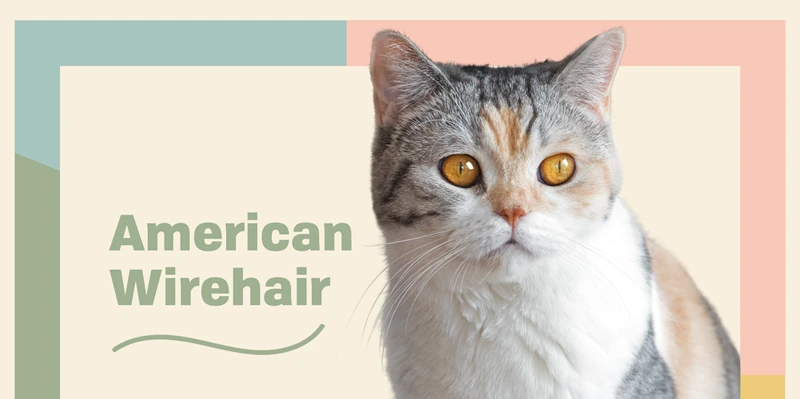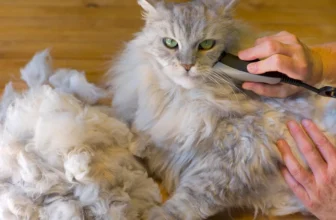American Wirehairs are a distinct breed of cat known for their unique wiry coat and charming personalities. While they are generally a healthy breed, they are prone to ear problems due to their ear structure. As a loving pet owner, it’s important to be aware of the warning signs of ear problems and to know when to seek professional help. In this comprehensive guide, we’ll cover everything you need to know about American Wirehair’s ear health, including common ear problems, warning signs, diagnosing and treating ear problems, and prevention tips. By the end of this guide, you’ll be equipped with the knowledge to keep your furry friend’s ears healthy and happy.
About American Wirehairs
American Wirehairs are a unique breed of cat known for their distinctive wiry coats and friendly, playful personalities. Originally bred in the United States, they make wonderful companions and are becoming increasingly popular as pets. However, like all cats, American Wirehairs are prone to certain health issues, particularly ear problems. If you are a cat owner, especially an American Wirehair owner, it is important to be aware of these issues to ensure your furry friend stays healthy and happy. To learn more about treating and preventing ear problems, check out our guide on Preventing Ear Problems in American Wirehairs.
Common Ear Problems in American Wirehairs
Ear problems are quite common in American Wirehairs, as is the case with most cats. These problems can be painful and uncomfortable for your furry friend and can potentially lead to hearing loss if not addressed in a timely manner. Here are some of the most common ear problems that American Wirehairs may experience:
- Ear mites: Ear mites are tiny parasites that infest a cat’s ears. They cause itching, discomfort, and inflammation, and if left untreated, can lead to secondary infections. Symptoms of ear mites include head shaking, scratching at the ears, and black discharge from the ear canal. Ear cleaning at home is not usually effective in treating ear mites, and it is advisable to seek professional help.
- Ear infections: American Wirehairs are susceptible to bacterial or yeast infections in their ears, especially if they have long hair around the ears that can trap moisture and bacteria. Typical symptoms of ear infections include head shaking, scratching at the ears, redness, swelling, and a foul odor from the ear. Prompt treatment is necessary to prevent the infection from spreading to the inner ear and causing permanent damage.
- Polyps: Polyps are benign growths that can occur in a cat’s ear canal. They can cause irritation, inflammation, and fluid buildup, leading to balance problems and hearing loss. Polyps usually require surgical removal, and early detection is critical.
Other less common ear problems that American Wirehairs may experience include ear canal obstructions, foreign bodies in the ear, and tumors. It is important to keep a close eye on your cat’s ear health and seek professional help if you notice any abnormalities or symptoms. Remember, prevention is always better than cure, and regular ear cleaning with the best ear cleaning solutions for American Wirehairs can go a long way in preventing ear problems.
Why Seek Professional Help?
Experiencing ear problems can be a painful and uncomfortable experience for American Wirehairs. Unfortunately, many pet owners might not be equipped with the necessary knowledge to handle the situation. It is imperative to seek professional help as soon as their furry friends showcase symptoms of ear problems.
Below is a table outlining the reasons why seeking professional help is crucial in treating American Wirehairs with ear problems:
| Why Seek Professional Help? | Explanation |
|---|---|
| Accurate Diagnosis | A professional veterinarian can accurately diagnose what type of ear problem your American Wirehair is experiencing. |
| Effective Treatment | A veterinarian can provide your pet with the most effective treatment plan for their specific ear problem. |
| Prevent Further Damage | If ear problems are left untreated, it can lead to further damage such as ear hematomas, which may require surgery. |
| Expert Knowledge | Veterinarians have the expert knowledge and experience when it comes to treating common and uncommon ear problems in pets. |
| Painless Procedures | A veterinarian can perform ear cleaning and treatment procedures with little to no pain or discomfort to the pet compared to home remedies. |
It is essential to rely on professional help when it comes to treating your American Wirehair’s ear problems to ensure that proper care and the best possible outcome is achieved. Home remedies and over-the-counter treatments can sometimes worsen the situation, leading to further damage and complications. To learn more about best ear cleaning solutions for American Wirehairs, click the link provided.
Warning Signs of Ear Problems

It’s important for American Wirehair owners to be able to recognize the signs of ear problems in their feline friends. While occasional ear scratching or shaking is normal, persistent or excessive behavior can indicate an underlying issue. Here are some warning signs to look out for:
- Scratching or Rubbing the Ears: If you notice your American Wirehair repeatedly scratching or rubbing their ears, this may be a sign of discomfort or irritation.
- Head Tilt or Shaking: Another telltale sign of ear problems is when your cat shakes their head or tilts it to one side. This behavior is often accompanied by scratching or rubbing.
- Odor or Discharge from the Ears: A foul smell or discharge coming from your cat’s ears should be addressed immediately, as it can indicate a bacterial or fungal infection.
- Redness or Swelling: Inflamed or swollen ears can be uncomfortable for your furry friend, and may indicate an infection or allergic reaction.
- Changes in Behavior: If your cat seems more irritable, lethargic, or withdrawn than usual, this could be a sign of an underlying health issue such as an ear infection.
If you notice any of these warning signs, it’s important to seek professional help from a veterinarian. Early detection and treatment can prevent more serious health problems down the line. To learn about how to prevent ear problems, check out our article on the best ear cleaning solutions for American Wirehairs.
Scratching or Rubbing the Ears
Scratching or rubbing the ears is one of the first warning signs that your American Wirehair may have an ear problem. It is essential to keep an eye out for this behavior and take action as soon as possible to prevent your cat from experiencing further discomfort. Below is a table summarizing what scratching or rubbing the ears in an American Wirehair might indicate and what action needs to be taken:
| Possible Indications | Action Needed |
|---|---|
| Ear mites or parasites | Visit a veterinarian as soon as possible for treatment |
| Allergies | Identify and remove the allergen if possible. Visit a veterinarian if necessary for medication |
| Infection | Visit a veterinarian for diagnosis and treatment |
| Foreign object in the ear canal | Visit a veterinarian for safe removal |
If you notice your American Wirehair scratching or rubbing its ears frequently or relentlessly, it’s crucial to investigate what is causing the behavior. Ear problems are not just uncomfortable for your cat; they can develop into something more severe and even lead to permanent hearing loss. So, be diligent with monitoring ear-related behavior, and take your furry friend to a veterinarian as soon as possible to avoid any potential complications.
Head Tilt or Shaking
One of the warning signs that your American Wirehair may be experiencing ear problems is head tilt or shaking. You may notice your cat shaking its head more frequently than usual, or tilting its head to one side. This can indicate discomfort or irritation in the ears.
If your cat is experiencing head tilt or shaking, it’s important to pay attention to other behaviors as well. Your cat may also scratch or rub at its ears, display changes in behavior, or have a discharge or odor from the ears.
What could be causing head tilt or shaking?
There are several reasons why your cat may be experiencing head tilt or shaking due to ear problems. Some of the most common causes include:
- Ear infections: These can be caused by bacteria, yeast, or ear mites and can cause irritation and inflammation in the ears.
- Foreign objects in the ear: Cats are curious animals and may get objects stuck in their ears, which can cause discomfort.
- Ear canal tumors: Although rare, tumors in the ear canal can cause head tilt or shaking and may require further examination by a veterinarian.
- Nerve damage: In some cases, head tilt or shaking may be a sign of nerve damage or a neurological disorder.
What should you do if you notice head tilt or shaking?
If you notice that your American Wirehair is experiencing head tilt or shaking, it’s important to seek professional help from a veterinarian as soon as possible. They can examine your cat’s ears and determine the root cause of the problem, and recommend a course of treatment accordingly. Depending on the severity of the issue, treatment options may include medication, cleaning the ears, or surgery.
Prevention is key
While some ear problems are unavoidable, there are several measures you can take to prevent them from occurring in the first place. Make sure to keep your cat’s ears clean and free of debris, regularly check for any signs of irritation or inflammation, and avoid exposing your cat to loud noises that may damage their ears. With proper care, you can help reduce the risk of your American Wirehair experiencing ear problems.
Odor or Discharge from the Ears
When checking for ear problems in American Wirehairs, one of the warning signs to look out for is odor or discharge from the ears. This symptom can indicate an infection or an infestation of ear mites.
When inspecting your cat’s ears, look for any visible signs of discharge or crusting around the ear canal. Additionally, take note of any strong or foul smells emanating from the ear. These odors can indicate the presence of bacteria or fungi, which can cause infections.
If you notice any discharge or odors coming from your cat’s ears, it is important to seek professional help. A veterinarian will be able to examine the ear and determine the root cause of the issue. They may take a sample of the discharge to identify any underlying infections or parasites.
Here is a table summarizing some potential causes of odor and discharge from the ears in American Wirehairs:
| Possible Cause | Symptoms |
|---|---|
| Ear infections | Odor, discharge, itching, redness, swelling |
| Ear mites | Dark discharge resembling coffee grounds, itching, head shaking, redness |
| Yeast or fungal infections | Odor, brown discharge, redness, irritation, thickening of skin in and around the ear canal |
Remember, early detection and treatment of ear problems is crucial for your cat’s overall health and well-being.
Redness or Swelling
Redness and swelling are common signs of ear problems in American Wirehairs. These symptoms indicate inflammation of the ear canal, which can be caused by a variety of factors such as allergies, infections, or foreign bodies.
Common Causes of Redness and Swelling in American Wirehair’s Ears
| Allergies | Allergies to environmental factors like dust, pollen, and mold can cause inflammation of the ear canal, leading to redness and swelling. |
| Infections | Bacterial or yeast infections are common in American Wirehairs and can cause redness, swelling, and discharge from the ears. |
| Foreign Bodies | A foreign object like a grass seed or a tick can get lodged in the ear canal of your American Wirehair, leading to irritation, swelling, and infection. |
If you notice redness or swelling in your American Wirehair’s ears, it is important to take action right away. These symptoms can cause discomfort and lead to further health problems if left untreated.
How to Treat Redness and Swelling in American Wirehair’s Ears
The best course of action is to visit a veterinarian who will examine your cat’s ears and determine the underlying cause of the inflammation. Treatment options may include:
- Antibiotics or antifungal medicine to treat an infection
- Ear drops or ointments to reduce inflammation and ease discomfort
- Removal of a foreign object from the ear canal
- Changes in diet or environment to address allergies
It is important to follow the veterinarian’s instructions closely and administer any prescribed medication as directed.
Preventing Redness and Swelling in American Wirehair’s Ears
While it may not be possible to prevent all ear problems in your American Wirehair, there are steps you can take to reduce the risk of redness and swelling. These include:
- Cleaning your cat’s ears regularly with a veterinarian-recommended solution and cotton balls
- Checking your cat’s ears frequently for signs of irritation or infection
- Keeping your cat’s environment clean and free of allergens
- Providing your cat with a high-quality diet that meets their nutritional needs
By taking these steps, you can help keep your American Wirehair’s ears healthy and free of discomfort. If you do notice any signs of redness or swelling, be sure to seek professional help right away to prevent further complications.
Changes in Behavior
It’s important to keep an eye out for changes in your American Wirehair’s behavior as they can often be a sign of ear problems. Here are some changes to look out for:
- Increased Irritability: If your normally calm and collected cat is suddenly grouchy and easily agitated, this could be a sign of ear pain.
- Lethargy: A cat with ear problems may also become more tired and listless than usual.
- Decreased Appetite: Cats with ear problems may also lose their appetite and be less interested in food.
- Avoiding Head Touches: If your cat is avoiding having their head touched, it could be a sign that touching their ears is causing pain.
- Unusually Vocal: If your cat is suddenly meowing or crying more than usual, it may because they are in pain from an ear infection.
If you notice any of these changes in your American Wirehair’s behavior, it’s important to seek professional help from a veterinarian. Ear problems can cause discomfort and pain, and if left untreated, can lead to more serious issues.
When to Visit a Veterinarian

As a responsible pet owner, it’s essential to keep an eye on your American Wirehair’s ear health. While regular cleaning and inspection at home can help prevent minor issues, it’s crucial to know when to seek professional help. If you notice any of the warning signs discussed earlier, it’s time to take your American Wirehair to the veterinarian. A licensed veterinarian will be able to diagnose the issue and provide appropriate treatment options. In this section, we’ll discuss what happens during a vet visit, how ear problems are diagnosed, and the available treatment options.
Diagnosing Ear Problems
Detecting ear problems in American Wirehairs is crucial because, if left untreated, they can lead to hearing loss and chronic ear infections. Here are some ways to diagnose ear problems in your feline:
- Physical Exam: During a physical examination, the veterinarian will look for redness, swelling, discharge, or any abnormal growth in your feline’s ears.
- Ear Cytology: The process involves taking a sample of earwax from your feline’s ear canal and looking at it under a microscope. This examination can help to detect ear infections and determine the type of microorganisms causing it.
- Blood Tests: In some cases, blood tests may be conducted to check for any underlying conditions that may be causing your feline’s ear problems.
- Endoscopy: An endoscope may be used to examine your feline’s ear canal in depth. Endoscopy can help to determine the severity of the infection and if any foreign object is lodged in the ear.
- Ear Culture: An ear culture is a laboratory test that aims to identify the microorganisms causing an ear infection. It can also help to identify the most effective treatment for your feline.
If any of the above tests indicate an ear infection, your veterinarian will prescribe appropriate medication to treat the infection. With prompt diagnosis and proper treatment, your feline can recover from ear problems quickly and maintain good ear health.
Treatment Options
There are several treatment options available for American Wirehairs with ear problems. The choice of treatment will depend on the severity of the issue and the underlying cause.
Medications: In most cases, medications will be prescribed by the veterinarian to treat ear infections. This may include antibiotics, antifungal medication, or corticosteroids to reduce inflammation and itchiness. It is important to administer medication as directed by the veterinarian to ensure the proper dose and duration of treatment.
Cleaning: Regular cleaning of the ears can help prevent and treat ear problems in American Wirehairs. Veterinarians may recommend a specific cleaning solution to use that is safe for cats. It is important to be gentle when cleaning the ears and avoid using cotton swabs which can cause further irritation.
Surgery: In severe cases of ear problems, surgery may be necessary. This may include removing a tumor or other growth, or ear canal surgery to treat chronic infections that do not respond to other treatments.
Home Remedies: While some pet owners may attempt to treat ear problems with home remedies, it is important to consult with a veterinarian before doing so. Some common home remedies, such as using vinegar or hydrogen peroxide to clean the ears, can actually make the problem worse.
It is crucial to seek professional help from a veterinarian if your American Wirehair is displaying signs of ear problems. The earlier the issue is diagnosed and treated, the better the prognosis for your pet.
Preventing Ear Problems in American Wirehairs
Maintaining good ear hygiene is key to preventing ear problems in your American Wirehair. Here are some tips to ensure your cat’s ears stay clean and healthy.
Clean Ears Regularly
American Wirehairs are prone to wax build-up in the ears, which can lead to ear infections. To prevent this, it’s important to clean their ears regularly. You can do this by gently wiping the inside of their ears with a soft cloth or cotton ball dipped in a cat-specific ear cleaner. However, it’s important to not go too deep into the ear canal as this can cause damage. It’s best to leave the deep cleaning to the professionals.
Check for Foreign Objects
It’s important to regularly check your American Wirehair’s ears for foreign objects such as dirt, grass, or other debris. These can cause irritation and infection. If you notice any foreign objects, gently remove them with a soft cloth or tweezers. However, if they are deeply embedded, it’s best to seek professional help.
Regular Vet Visits
Regular visits to the veterinarian are important not only for your cat’s overall health but also for their ear health. Your vet can check your cat’s ears for any signs of infection or other issues, and provide treatment if necessary.
Monitor Diet and Environment
A healthy diet and a clean environment can also contribute to your American Wirehair’s ear health. Make sure to feed your cat a balanced diet that meets their nutritional needs, and keep their living space clean and free of allergens that can cause ear irritation.
By following these tips, you can help prevent ear problems in your American Wirehair and ensure their ears stay healthy and clean. Remember, if you notice any signs of ear discomfort or infection, it’s important to seek professional help to ensure proper diagnosis and treatment.
Conclusion
In conclusion, it is important for American Wirehair owners to pay attention to their cat’s ear health. Ear problems can lead to discomfort and pain, as well as more serious issues if left untreated. Symptoms such as scratching or rubbing the ears, head tilt or shaking, odor or discharge from the ears, redness or swelling, and changes in behavior should not be ignored.
If you notice any of these warning signs, it is best to seek professional help from a veterinarian. They will be able to diagnose the problem and provide appropriate treatment options, whether it be medication, cleaning, or surgery.
Prevention is also key in maintaining your cat’s ear health. Regular cleaning and grooming can help prevent buildup of debris and bacteria in the ears. Additionally, a healthy diet and regular check-ups with a veterinarian can ensure overall wellness and prevent any underlying health issues.
By being proactive about your American Wirehair’s ear health, you can help ensure their comfort and well-being for years to come. Don’t hesitate to seek professional help when necessary and take preventative measures to avoid any future ear problems.
Frequently Asked Questions
1. What are the most common ear problems in American Wirehairs?
The most common ear problems in American Wirehairs are ear infections, ear mites, and allergies.
2. How can I prevent ear problems in my American Wirehair?
Regularly cleaning your American Wirehair’s ears and keeping them dry can help prevent ear problems. Additionally, avoid exposing your cat to substances that they are allergic to.
3. Can ear mites be transferred to humans?
While it is rare, ear mites can be transferred to humans. It is important to seek veterinary treatment if your cat has ear mites to prevent the spread to other pets and humans.
4. Is head shaking a symptom of ear problems in American Wirehairs?
Yes, head shaking can be a symptom of ear problems in American Wirehairs. Your cat may also tilt their head to one side or scratch at their ears frequently.
5. Can ear infections cause hearing loss in American Wirehairs?
If left untreated, severe ear infections in American Wirehairs can lead to hearing loss or even permanent damage. It is important to seek veterinary care promptly at the first sign of an ear infection.
6. How are ear infections in American Wirehairs diagnosed?
Your veterinarian will perform a physical examination and may take a sample of ear discharge to identify the cause of the infection. They may also recommend further testing, such as a culture or blood work.
7. What is the treatment for ear mites in American Wirehairs?
Ear mites in American Wirehairs can be treated with prescription ear drops or topical ointments. Your veterinarian may also recommend cleaning the ears and treating other pets in the household.
8. Are American Wirehairs more prone to ear problems than other cat breeds?
There is no evidence to suggest that American Wirehairs are more prone to ear problems than other cat breeds. However, proper ear care is important for all cats to prevent infections and other issues.
9. Can I use over-the-counter ear cleaning solutions on my American Wirehair?
It is important to only use veterinary-approved ear cleaning solutions on your American Wirehair. Over-the-counter products may not be suitable for cats and can cause further irritation or damage.
10. What can I do to make my American Wirehair more comfortable during treatment for ear problems?
You can help make your American Wirehair more comfortable during treatment by providing a warm and quiet environment, giving them plenty of water, and offering soft and cozy bedding. Additionally, be gentle when handling their ears and follow your veterinarian’s instructions closely.







